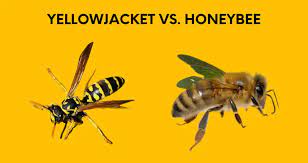
Honey Bee vs Yellow Jacket: Top 5 Unique Features

Ah, summertime! A season marked by backyard barbecues, picnics, and of course, the unmistakable buzz of insects in the air. Two ubiquitous characters in the cast of summer are the honey bee and the yellow jacket. Though they may share the same color palette and a penchant for buzzing around your outdoor activities, these creatures are fundamentally different in a myriad of fascinating ways.
This blog delves into the unique attributes that distinguish these two insects by laying out the top 5 unique features in a 'Honey Bee vs Yellow Jacket' showdown.
Social Structure: Eusociality vs Colonial Living
Honey Bees
Honey bees exhibit an intricate social system known as eusociality, characterized by a division of labor among specialized groups: workers, drones, and a queen. Workers forage for food, take care of the young, and defend the hive, among other responsibilities. The queen is the singular, egg-laying machine of the colony.
Yellow Jackets
Yellow jackets, on the other hand, also live in colonies but lack such well-defined roles. The female yellow jackets are generally responsible for foraging, nest construction, and rearing offspring.
Feeding Habits: Pollinators vs Predators

Honey Bees
One of the most important roles of honey bees is their job as pollinators. They forage for nectar and pollen, inadvertently transferring pollen between flowers, thus facilitating plant reproduction. This ecological function makes them essential for many ecosystems and agricultural practices.
Yellow Jackets
Yellow jackets are more opportunistic when it comes to their diet. They are predators that feast on other insects and are also scavengers, often found lingering around trash cans or picnic areas, looking for scraps of meat or sugary substances.
Nesting Habits: Waxed Castles vs Hidden Fortresses

Honey Bees
Honey bee hives are masterpieces of architectural genius, constructed from beeswax. These bees create beeswax from glands in their abdomen and use it to form hexagonal cells. Speaking of beeswax, "crimp wire beeswax foundation" is a method employed in apiculture to provide a foundation in man-made hives, allowing bees to build their comb in a consistent and structured manner.
Yellow Jackets
Yellow jackets build their nests underground or in concealed locations, using a paper-like material made from chewed wood fibers mixed with saliva. These nests can house thousands of yellow jackets and are typically hidden from sight.
Aggression Level: Defensive vs Offensive

Honey Bees
Honey bees are generally docile creatures and will only attack if they perceive a threat to their hive. Once they sting, they die, as their stinger is barbed and gets torn out of their body when they depart, making it a suicidal act of defense.
Yellow Jackets
Yellow jackets are more aggressive and territorial. Unlike honey bees, they can sting repeatedly without dying, making them a much-feared pest at outdoor activities.
Economic Importance: Honey and Pollination vs Pest Control
Honey Bees
Honey bees contribute significantly to agriculture through their role as pollinators. They also produce honey and beeswax, which have various uses, from food to cosmetics.
Yellow Jackets
Yellow jackets serve as natural pest controllers by preying on other insects. However, their aggressive nature and potential to deliver painful stings often overshadow this ecological role.
Conclusion
Understanding the differences between honey bees and yellow jackets is not only intellectually enriching but also practically useful, especially when spending time outdoors. Whether it's their contrasting social structures, feeding habits, nesting preferences, aggression levels, or economic impact, the "Honey Bee vs Yellow Jacket" debate presents an intriguing comparison of two commonly mistaken yet ecologically unique insects.
FAQs
1. Can both honey bees and yellow jackets sting?
To sting or not to sting—that is hardly a question! Both of these buzzers come equipped with stingers. Yet, the honey bee is somewhat of a tragic Shakespearean figure: it can sting only once before meeting its end. A yellow jacket, however, is a repeater in the world of stings. Oh yes, multiple zaps!
2. Are honey bees endangered?
Endangered? Hmmm. Well, a few of the honey bee species are, let's say, teetering on the brink of major challenges. We're talking about things like losing their homes, not to mention the dreadful pesticides and diseases. But labeling them as universally endangered is a bit of an overreach.
3. How can I differentiate between a honey bee and a yellow jacket?
Ah, the classic "Who's Who" among the bees and the jackets. Honey bees flaunt a fuzzier physique and their colors are—how should I put it—more muted. Yellow jackets, on the other hand, sport a sleeker, aerodynamic look, bright and alert. It's like comparing a comfy sweater to an Olympic swimsuit!
4. What is "crimp wire beeswax foundation"?
"Crimp wire beeswax foundation," you ask? Sounds like a high-tech gadget, but it's actually quite down to Earth. Think of it as a blueprint, an architectural guide that helps the honey bees lay down their honeycombs in straight, well-organized lines. Imagine an urban planner, but for bee cities!
5. Do yellow jackets make honey?
Don't let the "yellow" fool you; these fellas aren't in the honey-making business. Nope. Their menu leans towards proteins and other sugary treats they can scavenge or hunt. So, if you're craving something sweet, yellow jackets are not your go-to insects.
Ah, the ebb and flow of the honey bee vs. yellow jacket saga continue! Each has its own quirks, benefits, and drawbacks. Knowing their differences and peculiarities not only adds a layer of complexity to your insectoid understanding but can also save you from a stinging fiasco! So, next time you cross paths with one of these critters, you’ll be armed with more than just bug spray—you’ll have knowledge!



Leave a comment